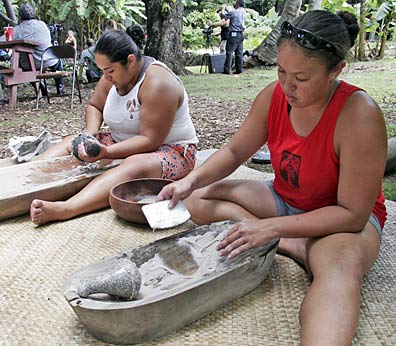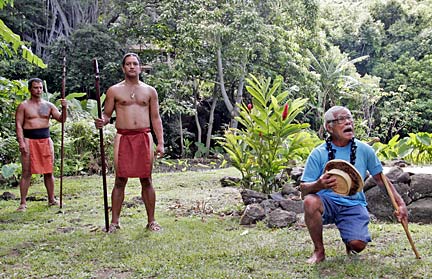Native Hawaiian teacher

|
UH vows to hold off
genetic tests with
Hawaiian taro
Researchers will consult
with native Hawaiians
on cultural concerns
|
Hawaiian varieties of taro will not be used in any University of Hawaii genetic engineering research until native Hawaiians advise scientists about cultural concerns, a university dean said yesterday.
VOICE CONCERNS
Anyone with concerns about genetic engineering of Hawaiian taro varieties can contact William Souza, of the Royal Order of Kamehameha, at 282-6005, or Andrew Hashimoto, dean of the University of Hawaii College of Tropical Agriculture and Human Resources, at 956-8234.
|
The dialogue is expected to take place through a process being organized by the Royal Order of Kamehameha on all islands.
To solidify the promise, Hashimoto signed a one-page statement about the university's intentions with taro research yesterday at a taro patch at the UH Center for Hawaiian Studies.
"We have encountered perceptions in the community that CTAHR's taro research focuses entirely on genetic engineering and that the college sells or gives away genetically engineered taro huli (shoots). These perceptions are incorrect," the statement said.
"The CTAHR scientists currently involved in genetic engineering research on taro have no plans to modify Hawaiian taro varieties."
The only ongoing genetic engineering of taro at the UH is of a Chinese variety and is being done only in a lab setting, not in greenhouses or open fields, Hashimoto said.

"Uncle" Eddie Kaanana, right, original caretaker of the Kanewai Lo'i, related his love and knowledge of taro during yesterday's "A Celebration for Haloa" at the Center for Hawaiian Studies in Manoa. At left are members of Na Koa from Ka Hale Mua, a Hawaiian group.
Opponents of genetic engineering worry that open-field test crops could escape test plots and affect native plants or other nongenetically engineered crops nearby, said Kat Brady of the environmental group Life of the Land.
But for taro, the cultural factor is an additional concern.
The connection between Hawaiians and taro goes beyond its historical use as a staple food to a "mystical, mythological parable that all Hawaiians are attached," said kumu John Lake, who chanted in Hawaiian, then spoke in English at yesterday's event.
"Kalo (taro) is intrinsically part and parcel of Hawaiians and of ohana," he said.
In Hawaiian mythology, the gods Wakea and Ho'ohokukalani's first child, Haloanakalaukapalili, was stillborn. When he was buried in the ground, he became the first taro plant, said Nalei Kahakalau, a teacher at the Big Island public charter school Kanu O Ka Aina.
The couple's next child, Haloa, was the founder of the Hawaiian people, according to the legend.
Visiting students from the Big Island charter school chanted about the legend for those attending the event.
The prospect of genetically altering taro is "kind of scary," said Ernest Tottori, president of Honolulu Poi Co., one of the islands' largest taro growers and processors.
For example, taro is known to be tolerated by people with allergies to wheat and rice, but Tottori asked what if it lost that quality under genetic engineering?
"You want to be very cautious about anything like that," he said.
E-mail to City Desk
[News] [Business] [Features] [Sports] [Editorial] [Do It Electric!]
[Classified Ads] [Search] [Subscribe] [Info] [Letter to Editor]
[Feedback]
